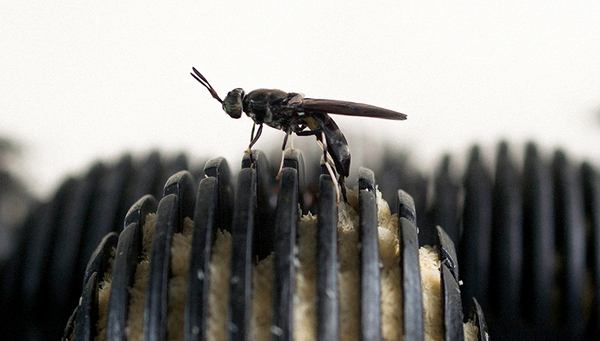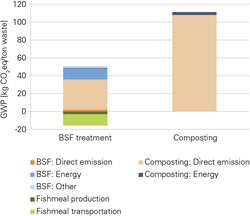News Detail
Fly larvae make biowaste disposal more climate friendly
February 19, 2019 |
As the world’s population continues to grow, the piles of biowaste also tower higher and higher. “In developing countries especially, there often isn’t enough money for proper waste disposal”, says Eawag researcher Christian Zurbrügg, “So, biowaste often ends up on primitive dumps.” Large quantities of greenhouse gases, especially methane, are emitted from such dumps, as well as even from typical composting facilities.
A group of researchers at Eawag working with Christian Zurbrügg are therefore investigating options for treating this kind of waste in the most efficient ways possible. They are focussing on the breeding of black soldier flies, the larvae of which feed on biowaste and break it down. These protein-rich larvae can then be used as animal feed afterwards.
“Emissions balance a mystery until now”
Thanks to these hungry larvae, smaller amounts of greenhouse gases end up in the atmosphere when they are deployed in comparison to a composting facility. However, emissions are given rise to elsewhere in a black soldier fly facility: electricity is needed to shred the waste and sieve the larvae. The residues that remain after the larvae have fed on the waste also need to be treated and disposed of. “The extent to which a black soldier fly facility is more climate friendly than a composting facility has always been a bit of a mystery up to now”, says Zurbrügg.
Together with his team, Zurbrügg therefore conducted a life-cycle analysis to total up all of the energy expenditure and emissions of a process. The team ascertained the levels of greenhouse gases emitted from a black soldier fly facility at a pilot facility in Surabaya, Indonesia. Research carried out at this facility has been supported financially for several years by the Swiss State Secretariat for Economic Affairs (SECO). The researchers obtained the figures for composting facilities from a review of the literature.
The results show that the global warming potential (GWP) is around half as high when biowaste is decomposed by larvae: just under 50 kilogrammes of CO2 equivalent per tonne of treated biowaste is produced with the larvae, in contrast to over 100 kg otherwise.
When biowaste is decomposed with the help of soldier-fly larvae, this cuts greenhouse gas emissions by around half compared to conventional composting.
(Source: Mertenant et al., 2019)
Substitute for fish meal
In their life-cycle analysis, the researchers went one step further: “Because the larvae are rich in protein and fat, they can be used as a substitute for fish meal”, says Christian Zurbrügg. In their analysis, they therefore included a calculation of the negative emissions that the larvae meal generates in contrast to fish meal. “This makes a facility like the one in Surabaya even more climate friendly, and reduces the global warming potential of greenhouse gases by 20 percent”, says Zurbrügg.


